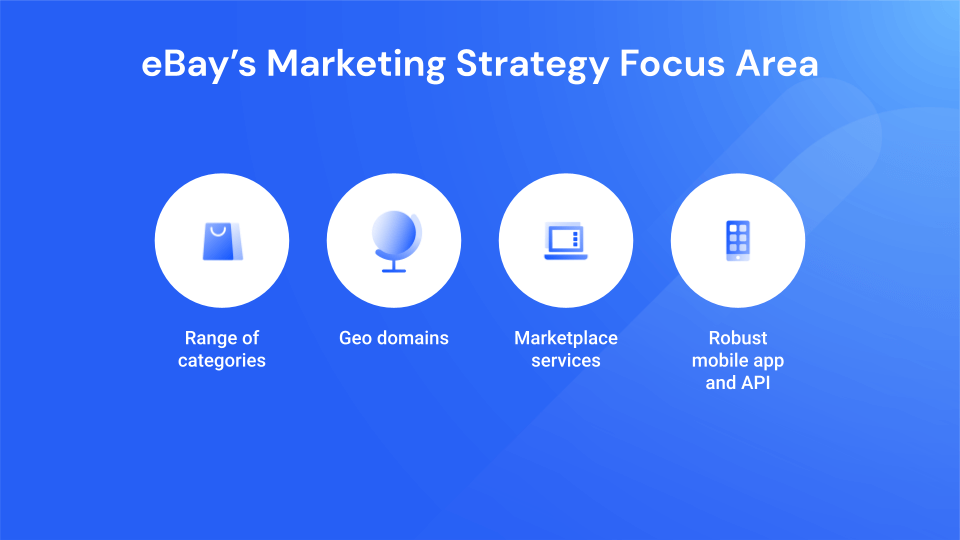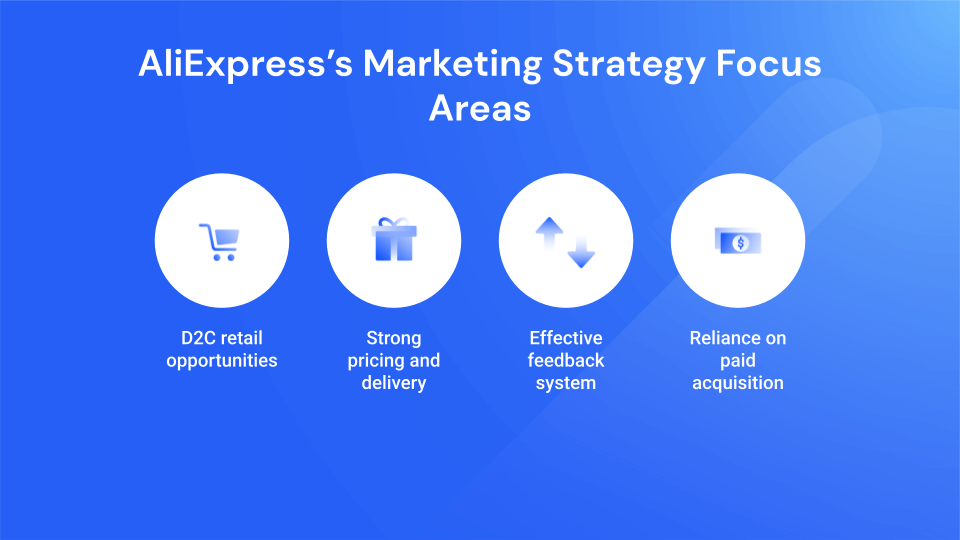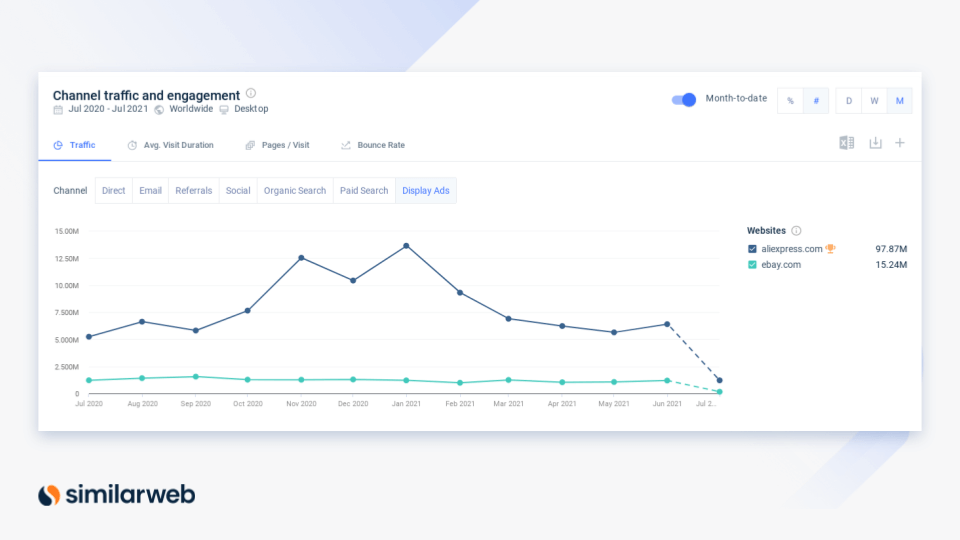AliExpress vs. eBay: The Battle for Global Market Share

Regarding the online retail industry, China-based eCommerce giant AliExpress brings strong competition to U.S. eCommerce marketplaces like eBay, as we can see in the map below displaying the top 15 countries where the companies get the most website traffic.
Powerhouse third-party sellers
Why are we comparing AliExpress vs. eBay?
Both are growth leaders in the online marketplace space for third-party sellers and have seen incredible growth over the past few years, each with a unique selling proposition. At the same time, there is a powerful increase in web searches by sellers looking for more information on how to succeed on these platforms.
To determine which regions these companies are winning market share and why these two contenders are growing so rapidly, we look at how they promote and sell.
Market domination: AliExpress vs. eBay
AliExpress aces emerging and EU markets
AliExpress’s digital strategy has focused on gaining a share in key emerging markets, which are some of the richest and most important markets for online retailers. Its achieved success in emerging markets like Brazil, China, and Russia, where it dominates a whopping 89.5%, 86.1%, and 82.6% of the market, respectively.
AliExpress is also making a widespread impact in important European markets, with more than 84% market share for aliexpress.com vs. eBay in these countries. Places where AliExpress is thriving include:
- France: 90.6% market share
- Spain: 94.7%
- Belgium: 84.6%
- Netherlands: 84.2%
eBay leads in the Americas
Meanwhile, eBay takes the lead in regions such as North, Central, and Latin America. It generates the most traffic in the United States (94.6%), Puerto Rico (94.1%), and Uruguay and Costa Rica with 63.9% and 74.3%, respectively.
Marketing channels bringing in traffic
There’s more to the story of AliExpress vs. eBay than the numbers. First, let’s explore the differences between eTailers and how they shine.
eBay marketing strategy explained
First and foremost, eBay has built a reputation on its service platform for sellers and as a place to find great deals for buyers. Therefore, it should be of little surprise that over the past year (July 2020–June 2021), direct and organic sources make up the majority of traffic to ebay.com worldwide on desktop.
This eBay marketing mix explains why it’s one of the first places both retailers and shoppers think of when buying from a variety of categories, including used or collectible items.
By focusing on marketplace services, eBay has been able to expand across the globe. Australia’s version of the website, ebay.com.au, exemplifies how the site has been able to consistently brand across many different demographic and cultural groups.
With the addition of partnerships through StubHub for ticket sales and Kijiji for classified listings, the eBay marketing mix for both buyers and sellers became well-rounded. eBay’s digital marketing strategy also includes a robust mobile app and API integrations to help the most ambitious and tech-savvy sellers get every bit they can from the platform.
eBay has built an incredible marketing arm. Even sellers with limited budgets, who can’t compete for the highest promoted spots or sell thousands of products a month, can benefit from the everyday marketing tasks eBay uses to promote the site as a whole. From email blasts to shoppers spreading awareness about coupons and promotions to reminders that they’ve left something in their cart, the eBay marketing strategy works hard to bring shoppers back to the site for regular buying sessions. This supports conversions in a powerful way.
AliExpress marketing strategy explained
If eBay is the nimble eCommerce platform, AliExpress may be the most ambitious. With its reported “102-year plan” communicated by Jack Ma in 2014, the company hopes to span three generations and change the face of global eCommerce on a scale no one has seen before. This “largeness” can’t be ignored, as the AliExpress strategy has focused on expanding its reach to be one of the most competitive global retailers around.
Skip the middleman to connect with consumers
How does it reach customers? First, it emphasizes its ability to connect. If a shopper wants something from China, they previously had to buy through a third-party (3P) retailer, wait for that company to get the product, or suffer through wait times from drop-shipping. It’s a case of the same product and process, but a much higher price was paid by the middleman retailer.
AliExpress now lets shoppers skip the middleman, in a sense. Prices are better, ship times can be slightly more predictable, and consumers are given much more variety of products to choose from. Whether shopping for personal needs or stocking their own business shelves, AliExpress changed the game in buying from this part of the globe.
Robust rating and feedback system
What little risk there is from buying from a global, potentially unknown seller, AliExpress has tried to mitigate. They have created a thriving rating and feedback system, which gives buyers and sellers a way to establish trust and could be one of the top measures coming out of the AliExpress marketing strategy.
Strategic marketing mix
Additionally, AliExpress has upped its marketing mix with more and more promotional tools for sellers, even for those who aren’t fluent in U.S. English or their marketing preferences. The platform has taken much of the work out of being an international business in the U.S. and continues to expand its marketing offerings to keep up with what consumers are looking for from an eCommerce option.
AliExpress invests more heavily in paid and display ads than eBay, particularly from November–February. This helped generate more visits for both the winter holidays and Chinese New Year (February 12, 2021), when consumers are more likely to shop.
Bottom line
When looking at the data and insights behind a killer marketing strategy, there is no one size fits all. Every company is different. To optimize your own performance, you need to consider how a successful strategy for a competitor could work for you.
The question you have to ask is, “which eCommerce strategy fits my brand or selling strategy?” Maybe it’s the AliExpress strategy with a global focus and accessibility. Others may be more drawn to the eBay digital marketing strategy, which focuses on customer shopping habits and includes strategic partnerships.
Having the most accurate and up-to-date data at your fingertips will help you monitor your market and identify market opportunities that work for you. To help, try tools such as Similarweb’s eCommerce solutions (Research and Shopper Intelligence) to analyze competitors’ performance on the web and across marketplaces like Amazon.
Further reading
Check out some of our other blogs on top eCommerce marketplaces to learn more:
- Shein vs. Amazon – Is Fast Fashion Dressed for Success?
- Amazon vs. Walmart: The Race to the Top
- Selling on Amazon vs. eBay: The eCommerce Showdown
- Ulta vs. Sephora: Which is the Best Fit for Your Brand? (+ Top Brands Ranked)
- Furniture Retailer Showdown: Overstock vs. Wayfair vs. Amazon vs. Ikea
- Top Dog Food Marketplaces for Better Sales Paw-tential
- Amazon vs. Shopify: Which Is Better in 2022?
- Target vs. Walmart: What Every eTailer Needs to Know
The ultimate edge in marketplace intelligence
Put the full picture at your fingertips to drive product views and sales













